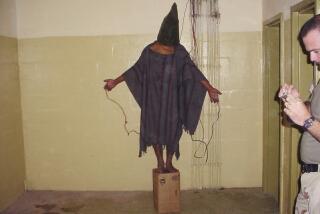O.C.’s Combat Veterans Court helps ex-warriors fix their lives
It took three arrests and the threat of prison to get Shaughn Whittington to Orange County’s Combat Veterans Court.
He slumped in a black suit, blue shirt and black tie, bracing for a claustrophobic courtroom, a stern judge.
No need. Here, defendants are called participants. People applaud. Judge Wendy Lindley hands out gift cards.
“It looks more like a support group instead of a courtroom,” said Whittington, 27, who was arrested twice on drug charges and once on suspicion of assault. “It’s that Marine Corps mentality. You look at it like it’s a joke.”
Not anymore.
Whittington is among a growing number of military veterans who as warriors survived the battlefield but as civilians collided with the criminal justice system. There are now more than 90 courts across the U.S., including nine in California, tailored to veterans willing to work to repair their lives.
Buffalo, N.Y.’s was the first, launched in January 2008 and modeled on the traditional drug court; Orange County’s and Santa Clara County’s weren’t far behind. Although the process is neither easy nor quick — it takes some veterans years to complete Lindley’s program — the three courts have become models of success.
Yet Lindley’s stands apart nationally. It is designed exclusively for combat veterans. As a longtime Superior Court judge, she has seen what the residue of combat stress can do.
“We are dealing with people whose mental and physical health is very compromised,” she said. “We owe them, each one of them, the highest level of care.”
She designed her court to be especially sensitive to war’s psychic wounds, which are difficult to understand, let alone heal. Participation is voluntary; only murder cases are ineligible.
Capped at 50 to ensure individualized treatment, what began with five participants is now fully booked. From 2010 to 2011, the number of people referred to the program jumped 41%. As with other veterans courts, if a judge’s criteria — including steady employment, staying clean and sober — are met, charges can be dropped or reduced.
Those in Lindey’s program share more than battlefield experience. All had been diagnosed with post-traumatic stress disorder, often with additional war-related complications such as traumatic brain injury. And she hadn’t even been looking for these conditions as a requirement.
Nor did she come by this accidentally. Her epiphany came in drug court, when a veteran on her docket died of an overdose. He had been diagnosed with PTSD, which can be marked by such signs as depression, memory loss and substance abuse.
“He was young and I just felt he needed a much higher level of competent services,” Lindley said. “On my watch, I didn’t want to have any more deaths.”
Her weekly sessions provide a one-stop service, bringing together representatives from the district attorney’s office and the U.S. Department of Veterans Affairs’ Justice Outreach program, along with probation officers and volunteer mentors. Each veteran is carefully evaluated by a team, including Lindley, before being accepted into the program.
There recently has been a sharp spike in California combat veterans enrolled in healthcare services — which include counseling — through the VA. The number jumped to 47,819 last year from 3,609 in 2003, when the Iraq war began. There are waiting lists.
Lindley’s mantra is simple: no alcohol, no drugs, no bad friends.
“It’s all a big plan for them to be exposed to the possibility of change,” she said. “It’s brainwashing in a way. In brainwashing that, there is hope for a better future.”
The results so far are striking: 21 graduates, none of whom have had any new convictions or arrests.
Broken into four phases, her program is no cakewalk. To advance, participants must pass drug tests, attend counseling, show up regularly in court and write personal essays. Some drop out, unable to stick with it.
“Sometimes I have to remind them,” said Andrea Serafin, Justice Outreach coordinator for Lindley’s court. “‘Remember when you begged and pleaded to do this?’”
Eileen Moore, a former Vietnam War combat nurse, is one of the mentors. An associate justice with the California Court of Appeal, she said the camaraderie in the program is “palpable.”
“During the first phase you can see these — they’re mostly young men — you can see them with their head hung and they are filled with shame,” Moore said. Then in the fourth phase, “they look proud and they look hopeful. That’s not something we see with your run-of-the mill criminal. These young men are different.”
Paul Freese, vice president of the Public Counsel Law Center, calls Lindley’s court the “gold standard.”
“This is by far the model we want people to emulate,” he said. “Individuals don’t have to go from place to place to place to get the services that they need.”
Chris Deutsch, director of communications with Justice for Vets, a veterans court advocacy and training group, said that Lindley’s program is unique but that in many of the courts, “the outcomes are astonishing.”
There are similar rates of success in Buffalo and San Jose, where veterans are routed as part of sentencing. In San Jose, there have been 72 graduates and only six new convictions, and in Buffalo, there have been 71 graduates — none of whom have since been in trouble with the law. .
“I think now there is a concerted effort to look at what ways to engage veterans, to reduce the presence of veterans in the criminal justice system,” said Judge Robert Russell, the man behind Buffalo’s program. “This war was a different war.”
Los Angeles County launched a veterans court in 2010 and accepts only veterans facing felony charges, not misdemeanors. It expects its first graduates Tuesday.
“If these guys don’t get help, I think they’re going to deteriorate,” said Superior Court Judge Michael Tynan, who oversees about 75 veterans in the L.A. County program.
Santa Clara County Superior Court Judge Stephen Manley, though, is worried.
“I think the numbers are going to be far larger than we are ready for and what the Veterans Administration has planned for,” said Manley, who recently expanded his San Jose program to twice a week. “We are seeing more crimes that are more serious. We are seeing violence.”
Manley’s program, which typically lasts 15 to 18 months and has about 150 enrolled, includes counseling and job-training.
As for Whittington’s case, the story is familiar. Deployed as a mortar man in the Iraq invasion, he returned to civilian life in 2005. The transition was fitful at best. He was diagnosed with PTSD and, later, traumatic brain injury.
There are scraps of war memories, like bullets whistling past him, inches away from his head. There was a recurring nightmare from the battlefield. He was angry, depressed. Fearing he might hurt his then-wife, he started sleeping in a different bed. Vices took hold. He started popping narcotic pain relievers and smoking meth.
Then he found himself in Lindley’s court.
“You start coming out of a coma, pretty much,” said Whittington, who checked into an in-patient treatment center during Phase 1. “You start realizing all the damage you did to the people around you.”
In Phase 2, Whittington moved into his own apartment. He said the program helped him manage new responsibilities such as paying rent. He attends Golden West College in Huntington Beach, where he is studying auto mechanics and is on the honor roll.
Phase 3 focused on “stabilization and mentoring.” He is spending more time with his 7-year-old daughter; instead of dropping her off to stay with her mother on Sunday nights, he takes the girl to school on Monday mornings. He even gave up cigarettes.
“Once I started doing things right, I saw how much easier it made everything on myself and everyone else around me,” Whittington said. He is set to begin Phase 4 on Tuesday.
With 13 months of sobriety, he isn’t likely to forget how far he’s come.
“Every time I walk into the courtroom,” he said, “just seeing the holding cell — that in itself is a reminder.”
More to Read
Start your day right
Sign up for Essential California for news, features and recommendations from the L.A. Times and beyond in your inbox six days a week.
You may occasionally receive promotional content from the Los Angeles Times.







